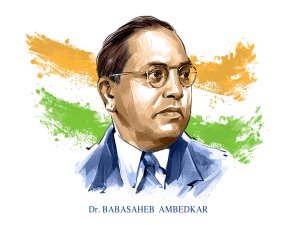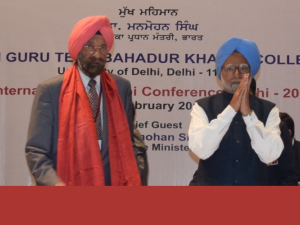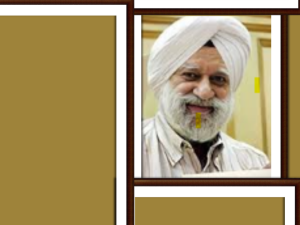American based S. Narinder Singh Kapany was one of the most popular and respected Sikhs who did maximum to promote and preserve Sikh Art and Heritage. I think no one else has done such a unique service in this field. It was because of him that in 1999, the 300th year of the birth of Khalsa, the first exhibition on the Sikhs was held in Victoria and Albert Museum London. He also organized exhibitions Arts of Sikh Kingdom in San Francisco and Toranto.
Born on October 31st 1926 in Punjab, Dr. Kapany resided in San Francisco for many decades. He set up Sikh Foundation in 1967, as a non-political organization to preach Sikhism in the West. Maharaja Yadvinder Singh of Patiala was the President.
Dr. Kapany endowed a chair of Sikh studies at the University of California, Santa Barbara. He gifted 5 lac dollars in 1999 to the Asian Arts Museum in San Francisco to establish a Sikh Gallery and donated artifacts from his collection. An exhibition ‘Splendors of the Punjab: Sikh Art and Literature was organized by him in 1992 in Berkeley University to celebrate the 25th anniversary of the Sikh Foundation.
Sikh Foundation has an online publication of the ‘Sikh Research Journal’ and also has an online store which provides a wide collection of books of Art and other subjects related to Sikhs and Sikhism. The Foundation funded the renovation of Guru Ki Maseet in Hargobindpur Punjab through UNESCO which was handed over to the Muslim Community. This was hailed all over by the people.
The Foundation is publishing a 12 page colored annual Sikh Art Calendar which is in great demand all over the world. I may add here that the First Sikh Art Calendar was published by me in 1971, when I was posted in Markfed. The Foundation has published a dozen books on subjects ranging from religion, history, art and culture of the Sikhs including children’s books. It has also published two journals, greeting cards and Fine Art posters. The well known popular books published by the Foundation are:
The Sikhs and their Religion (1968), Guru Gobind Singh: Reflections and Offerings (1969), Warrior Saints (1999), Arts of the Sikh Kingdoms (1999), The Name of my Beloved (2001), I See No Stranger (2006).
Dr. Kapany was a collector of Sikh Relics. He spent huge money in acquiring the coins, miniature paintings, and jewelry relating to the Guru period and Maharaja Ranjit Singh. When a group of Sikhs were able to open a Sikh gallery in the Massachusetts Museum in Washington D.C., Dr. Kapany was kind enough to give some rare Sikh relics to them. I was there along with him at the inauguration ceremony.
Kapany encouraged many artists to make documentaries on Sikhism and encouraged many Authors to write books on Sikh Philosophy. Kapany was given an honorary doctorate by Guru Nanak Dev University in 2001. He was also given the prestigious Parvasi Bhartiya Award by Shri Atal Bihari Vajpayee, the Prime Minister of India, in 2002.
Dr. Narinder Singh Kapany is recognized as the “Father of Fiber Optics”. On a global scale, Kapany’s research in the 1950’s led to the development of Fiber optics and he was the first person to demonstrate the transmission of an image through a bundle of glass fibres. The word Fiber Optics was coined by him. Furthermore these Fibers are responsible for the transmission of higher bandwidths of information over great distances, in which their applications over the past few decades have revolutionized countless industries, including medical, communications, entrainment, networking and business. Without Kapany’s ground breaking gifts to science, none of this technology would have been invented and the very nature of our world would have been dramatically different today.
Dr. Kapany was privileged to have a brilliant wife Satinder Kaur without whom he would have been someone quite different. When I met both of them in 2003 in Delhi he told me that he always received encouragement and support from his wife in his long battle to achieve a miracle in Fiber Optics. A charming personality, she took a keen interest in the Sikh Foundation and encouraged many scholars to write books on Sikh Philosophy. Dr. Kapany named the Sikh chair in Santa Barbara after his loving wife.
This scientific genius hailing from Punjab was recognized as one of the seven ‘Unsung Heroes’ by Fortune magazine in their ‘Businessman of the Century’ issue in 1999. It is to the credit of Kapany that more than 90 patents are named after him which are being used in the sputniks and other scientific industries. Kapany received many International awards. He was a fellow of numerous scientific societies including the British Royal Academy of Engineering, the optical society of America and the American Association for the Advancement of Science.
We are all grateful to Prime Minister Narinder Modi for recognizing the services of Kapany and conferring Padma Vibhushan, the highest Civilian Award by Govt. of India to him. Kiki Kapany who is carrying on his legacy received this award in a glittering ceremony in Rashtrapti Bhawan from the President of India.
We are proud that a Sikh attained such a high position and respect in the scientific world and devoted the maximum time to promote Sikhi. I’m privileged to have met his illustrious father in 1973 in Dehradun, who was associated with Bhai Vir Singh Ji and his brother Dr. Balbir Singh. His uncle S. Mangal Singh I.A.S. was an administrator and a renowned P.R. man who worked with Maharaja Yadvinder Singh of Patiala.
I am happy Kapany’s family is keeping the torch bright.





